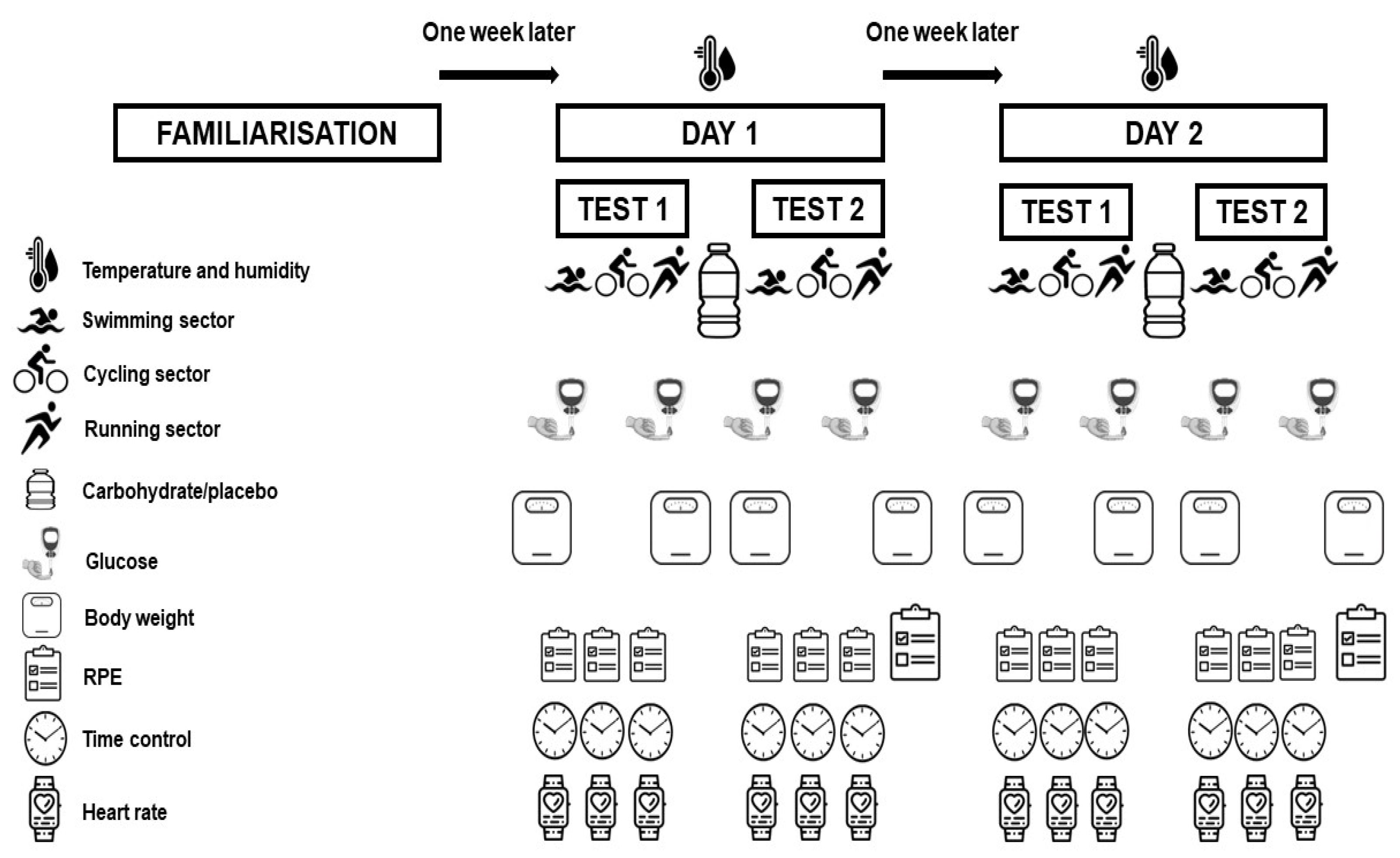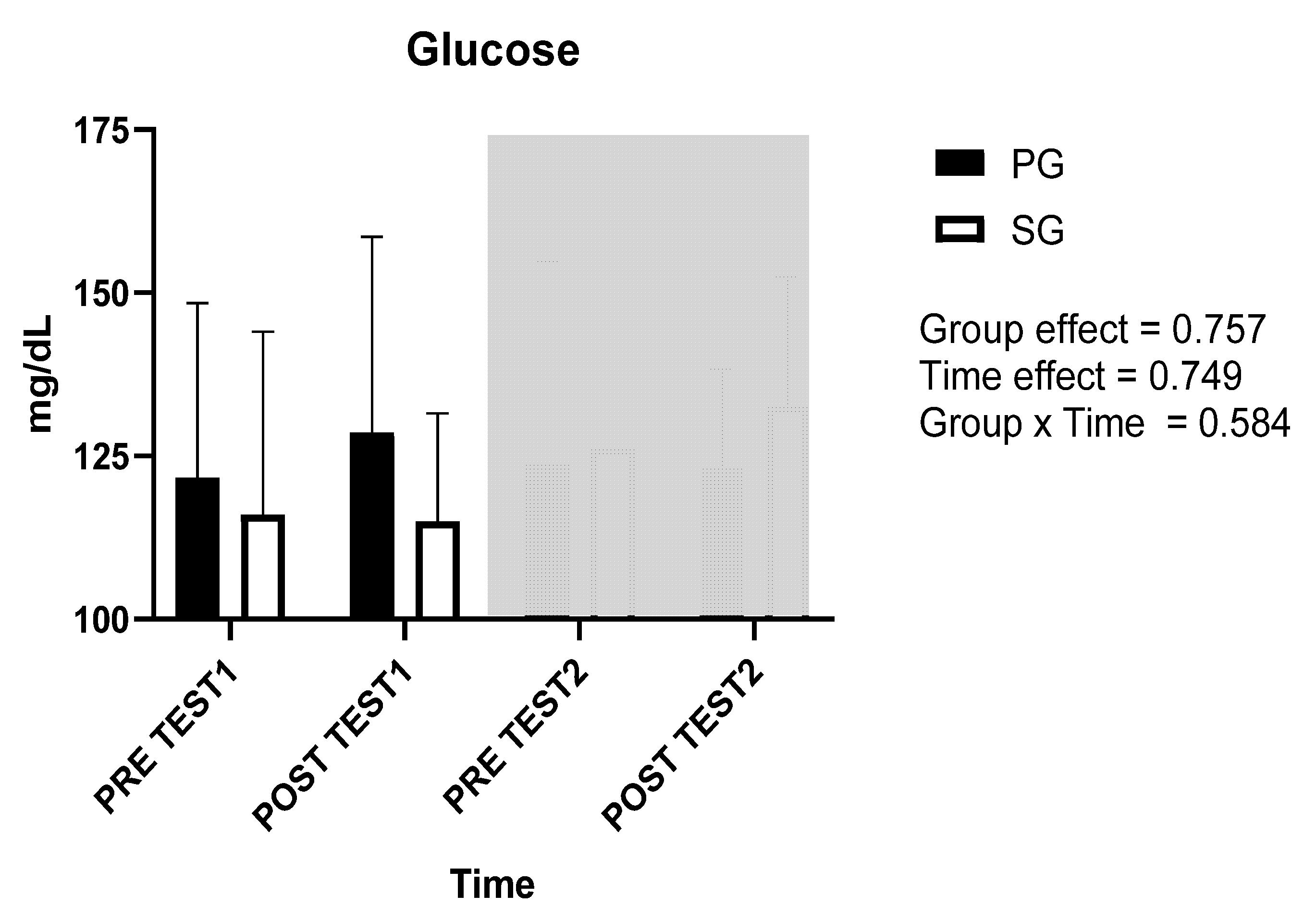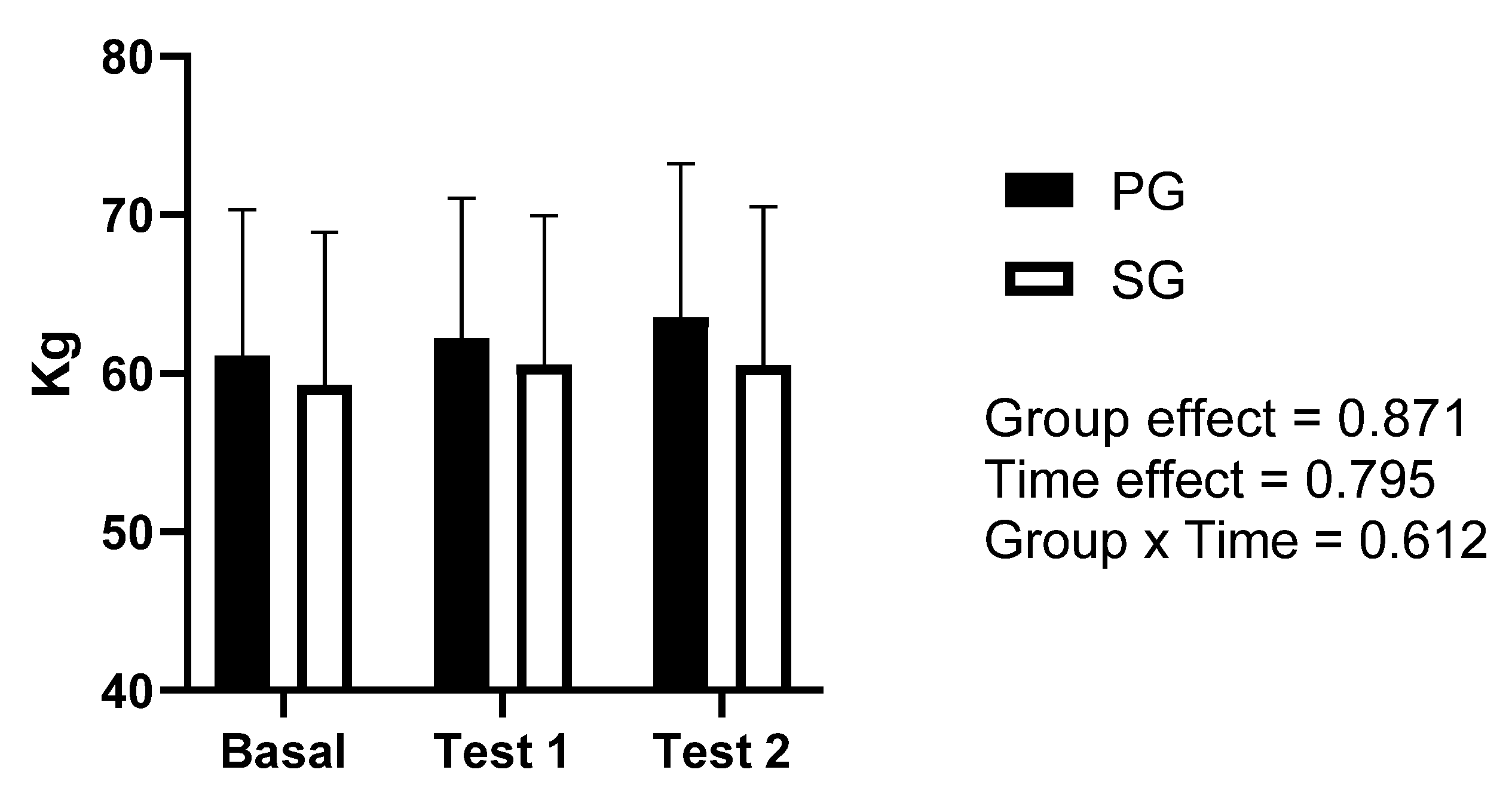Effect of Combined Intra-Session Glucose and Fructose Intake on the Performance of Young Super-Sprint Triathletes: A Randomised, Crossover, Blind, Placebo-Controlled Study
Abstract
1. Introduction
2. Materials and Methods
2.1. Study Design
2.2. Sample
2.3. Nutritional Intake on Previous Days
2.4. Anthropometry
2.5. Test
2.6. Blood Glucose Assessment
2.7. RPE and Heart Rate Assessment
2.8. Carbohydrate Intake and Placebo
2.9. Statistical Analysis
3. Results
4. Discussion
5. Conclusions
Author Contributions
Funding
Institutional Review Board Statement
Informed Consent Statement
Data Availability Statement
Conflicts of Interest
References
- Costa, R.J.S.; Hoffman, M.D.; Stellingwerff, T. Considerations for Ultra-Endurance Activities: Part 1-Nutrition. Res. Sports Med. 2019, 27, 166–181. [Google Scholar] [CrossRef] [PubMed]
- Cejuela, R.; Pérez Turpin, J.A.; Villa Vicente, J.G.; Cortell-Tormo, J.M.; Rodríguez Marroyo, J.A. Análisis de Los Factores de Rendimiento En Triatlón Distancia Sprint. J. Hum. Sport. Exerc. 2007, 2, 1–25. [Google Scholar] [CrossRef]
- Sharma, A.P.; Périard, J.D. Physiological Requirements of the Different Distances of Triathlon. In Triathlon Medicine; Springer: Cham, Switzerland, 2020; pp. 5–17. [Google Scholar]
- Burke, L.M.; Cox, G.R. Nutrition Strategies for Triathlon. In Triathlon Medicine; Springer: Cham, Switzerland, 2020; pp. 261–287. [Google Scholar]
- Jeukendrup, A.E.; Jentjens, R.L.P.G.; Moseley, L. Nutritional Considerations in Triathlon. Sports Med. 2005, 35, 163–181. [Google Scholar] [CrossRef] [PubMed]
- Heung-Sang Wong, S.; Sun, F.-H.; Chen, Y.-J.; Li, C.; Zhang, Y.-J.; Ya-Jun Huang, W. Effect of Pre-Exercise Carbohydrate Diets with High vs. Low Glycemic Index on Exercise Performance: A Meta-Analysis. Nutr. Rev. 2017, 75, 327–338. [Google Scholar] [CrossRef] [PubMed]
- Sánchez Oliver, A.J.; Mata Ordoñez, F.; Valenzuela, P.L.; Giménez, J.; Tur, C.; Ferreria, D.; Domínguez, R.; Martínez Sanz, J.M. Carbohydrate Availability and Physical Performance: Physiological Overview and Practical Recommendations. Nutrients 2019, 11, 1084. [Google Scholar] [CrossRef] [PubMed]
- Jeukendrup, A.E. Nutrition for Endurance Sports: Marathon, Triathlon, and Road Cycling. J. Sports Sci. 2011, 29, S91–S99. [Google Scholar] [CrossRef] [PubMed]
- Smith, J.W.; Pascoe, D.D.; Passe, D.H.; Ruby, B.C.; Stewart, L.K.; Baker, L.B.; Zachwieja, J.J. Curvilinear Dose-Response Relationship of Carbohydrate (0-120 G·h-1) and Performance. Med. Sci. Sports Exerc. 2013, 45, 336–341. [Google Scholar] [CrossRef]
- Burdon, C.A.; Spronk, I.; Cheng, H.L.; O’Connor, H.T. Effect of Glycemic Index of a Pre-Exercise Meal on Endurance Exercise Performance: A Systematic Review and Meta-Analysis. Sports Med. 2017, 47, 1087–1101. [Google Scholar] [CrossRef] [PubMed]
- Donaldson, C.M.; Perry, T.L.; Rose, M.C. Glycemic Index and Endurance Performance. Int. J. Sport. Nutr. Exerc. Metab. 2010, 20, 154–165. [Google Scholar] [CrossRef] [PubMed][Green Version]
- Toro-Román, V.; Siquier-Coll, J.; Bartolomé, I.; Grijota, F.J.; Muñoz, D.; Maynar-Mariño, M. Copper Concentration in Erythrocytes, Platelets, Plasma, Serum and Urine: Influence of Physical Training. J. Int. Soc. Sports Nutr. 2022, 18, 28. [Google Scholar] [CrossRef] [PubMed]
- Kreider, R.B.; Wilborn, C.D.; Taylor, L.; Campbell, B.; Almada, A.L.; Collins, R.; Cooke, M.; Earnest, C.P.; Greenwood, M.; Kalman, D.S. ISSN Exercise & Sport Nutrition Review: Research & Recommendations. J. Int. Soc. Sports Nutr. 2010, 7, 7. [Google Scholar]
- Jeukendrup, A.E.; Moseley, L. Multiple Transportable Carbohydrates Enhance Gastric Emptying and Fluid Delivery. Scand. J. Med. Sci. Sports 2010, 20, 112–121. [Google Scholar] [CrossRef]
- Jentjens, R.L.P.G.; Shaw, C.; Birtles, T.; Waring, R.H.; Harding, L.K.; Jeukendrup, A.E. Oxidation of Combined Ingestion of Glucose and Sucrose during Exercise. Metabolism 2005, 54, 610–618. [Google Scholar] [CrossRef]
- Jeukendrup, A.E. Periodized Nutrition for Athletes. Sports Med. 2017, 47, 51–63. [Google Scholar] [CrossRef]
- Rowlands, D.S.; Houltham, S.D. Multiple-Transportable Carbohydrate Effect on Long-Distance Triathlon Performance. Med. Sci. Sports Exerc. 2017, 49, 1734–1744. [Google Scholar] [CrossRef]
- Smith, G.J.; Rhodes, E.C.; Langill, R.H. The Effect of Pre-Exercise Glucose Ingestion on Performance during Prolonged Swimming. Int. J. Sport. Nutr. 2002, 12, 136–144. [Google Scholar] [CrossRef]
- McGawley, K.; Shannon, O.; Betts, J. Ingesting a High-Dose Carbohydrate Solution during the Cycle Section of a Simulated Olympicdistance Triathlon Improves Subsequent Run Performance. Appl. Physiol. Nutr. Metab. 2012, 37, 664–671. [Google Scholar] [CrossRef]
- Cox, G.R.; Snow, R.J.; Burke, L.M. Race-Day Carbohydrate Intakes of Elite Triathletes Contesting Olympic-Distance Triathlon Events. Int. J. Sport. Nutr. Exerc. Metab. 2010, 20, 299–306. [Google Scholar] [CrossRef][Green Version]
- Haff, G.G.; Stone, M.H.; Warren, B.J.; Keith, R.; Johnson, R.L.; Nieman, D.C.; Franklin Williams, J.R.; Kirksey, K.B. The Effect of Carbohydrate Supplementation on Multiple Sessions and Bouts of Resistance Exercise. J. Strength Cond. Res. 1999, 13, 111–117. [Google Scholar]
- Haff, G.G.; Koch, A.J.; Potteiger, J.A.; Kuphal, K.E.; Magee, L.M.; Green, S.B.; Jakicic, J.J. Carbohydrate Supplementation Attenuates Muscle Glycogen Loss during Acute Bouts of Resistance Exercise. Int. J. Sport Nutr. Exerc. Metab. 2000, 10, 326–339. [Google Scholar] [CrossRef]
- Eckstein, M.L.; Erlmann, M.P.; Aberer, F.; Haupt, S.; Zimmermann, P.; Wachsmuth, N.B.; Schierbauer, J.; Zimmer, R.T.; Herz, D.; Obermayer-Pietsch, B. Glucose and Fructose Supplementation and Their Acute Effects on Anaerobic Endurance and Resistance Exercise Performance in Healthy Individuals: A Double-Blind Randomized Placebo-Controlled Crossover Trial. Nutrients 2022, 14, 5128. [Google Scholar] [CrossRef]
- King, A.; Helms, E.; Zinn, C.; Jukic, I. The Ergogenic Effects of Acute Carbohydrate Feeding on Resistance Exercise Performance: A Systematic Review and Meta-Analysis. Sports Med. 2022, 52, 2691–2712. [Google Scholar] [CrossRef]
- Siquier-Coll, J.; Collado-Martín, Y.; Sánchez-Puente, M.; Grijota-Pérez, F.J.; Pérez-Quintero, M.; Sánchez, I.B.; Muñoz-Marín, D. Estudio Comparativo de Las Variables Determinantes de La Condición Física y Salud Entre Jóvenes Deportistas y Sedentarios Del Género Masculino. Nutr. Hosp. 2018, 35, 689–697. [Google Scholar] [CrossRef]
- Bergeron, M.F.; Mountjoy, M.; Armstrong, N.; Chia, M.; Côté, J.; Emery, C.A.; Faigenbaum, A.; Hall, G.; Kriemler, S.; Léglise, M. International Olympic Committee Consensus Statement on Youth Athletic Development. Br. J. Sports Med. 2015, 49, 843–851. [Google Scholar] [CrossRef]
- Armstrong, N.; McManus, A.M. Physiology of Elite Young Male Athletes. Med. Sport Sci. 2011, 56, 1–22. [Google Scholar]
- Armstrong, N.; Barker, A.R.; McManus, A.M. Muscle Metabolism Changes with Age and Maturation: How Do They Relate to Youth Sport Performance? Br. J. Sports Med. 2015, 49, 860–864. [Google Scholar] [CrossRef]
- Bergeron, M.F. The Youth Triathlete. In Triathlon Medicine; Springer: Cham, Switzerland, 2020; pp. 185–194. [Google Scholar]
- Boisseau, N.; Delamarche, P. Metabolic and Hormonal Responses to Exercise in Children and Adolescents. Sports Med. 2000, 30, 405–422. [Google Scholar] [CrossRef]
- Williams, N. The Borg Rating of Perceived Exertion (RPE) Scale. Occup. Med. 2017, 67, 404–405. [Google Scholar] [CrossRef]
- Hopkins, W.G.; Marshall, S.W.; Batterham, A.M.; Hanin, J. Progressive Statistics for Studies in Sports Medicine and Exercise Science. Med. Sci. Sports Exerc. 2009, 41, 3–13. [Google Scholar] [CrossRef]
- Ramos-Campo, D.J.; Clemente-Suárez, V.J.; Cupeiro, R.; Benítez-Muñoz, J.A.; Andreu Caravaca, L.; Rubio-Arias, J.Á. The Ergogenic Effects of Acute Carbohydrate Feeding on Endurance Performance: A Systematic Review, Meta-Analysis and Meta-Regression. Crit. Rev. Food Sci. Nutr. 2023, 1–10. [Google Scholar] [CrossRef]
- Rowe, J.T.; King, R.F.G.J.; King, A.J.; Morrison, D.J.; Preston, T.; Wilson, O.J.; O’hara, J.P. Glucose and Fructose Hydrogel Enhances Running Performance, Exogenous Carbohydrate Oxidation, and Gastrointestinal Tolerance. Med. Sci. Sports Exerc. 2022, 54, 129–140. [Google Scholar] [CrossRef] [PubMed]
- Rosset, R.; Egli, L.; Lecoultre, V. Glucose–Fructose Ingestion and Exercise Performance: The Gastrointestinal Tract and Beyond. Eur. J. Sport. Sci. 2017, 17, 874–884. [Google Scholar] [CrossRef] [PubMed]
- Migliorini, S. Triathlon Medicine; Springer: Cham, Switzerland, 2020. [Google Scholar]
- Sim, M.; Garvican-Lewis, L.A.; Cox, G.R.; Govus, A.; McKay, A.K.A.; Stellingwerff, T.; Peeling, P. Iron Considerations for the Athlete: A Narrative Review. Eur. J. Appl. Physiol. 2019, 119, 1463–1478. [Google Scholar] [CrossRef] [PubMed]
- Thomas, D.T.; Erdman, K.A.; Burke, L.M. Nutrition and Athletic Performance. Med. Sci. Sports Exerc. 2016, 48, 543–568. [Google Scholar] [PubMed]
- Kenney, W.L.; Wilmore, J.H.; Costill, D.L. Physiology of Sport and Exercise; Human Kinetics: Champaign, IL, USA, 2021; ISBN 1718201729. [Google Scholar]
- Knuiman, P.; Hopman, M.T.E.; Mensink, M. Glycogen Availability and Skeletal Muscle Adaptations with Endurance and Resistance Exercise. Nutr. Metab. 2015, 12, 59. [Google Scholar] [CrossRef] [PubMed]
- Rouillier, M.-A.; David-Riel, S.; Brazeau, A.-S.; St-Pierre, D.H.; Karelis, A.D. Effect of an Acute High Carbohydrate Diet on Body Composition Using DXA in Young Men. Ann. Nutr. Metab. 2015, 66, 233–236. [Google Scholar] [CrossRef] [PubMed]
- Shiose, K.; Takahashi, H.; Yamada, Y. Muscle Glycogen Assessment and Relationship with Body Hydration Status: A Narrative Review. Nutrients 2022, 15, 155. [Google Scholar] [CrossRef] [PubMed]
- Urdampilleta, A.; Arribalzaga, S.; Viribay, A.; Castañeda-Babarro, A.; Seco-Calvo, J.; Mielgo-Ayuso, J. Effects of 120 vs. 60 and 90 g/h Carbohydrate Intake during a Trail Marathon on Neuromuscular Function and High Intensity Run Capacity Recovery. Nutrients 2020, 12, 2094. [Google Scholar] [CrossRef] [PubMed]
- King, A.J.; Etxebarria, N.; Ross, M.L.; Garvican-Lewis, L.; Heikura, I.A.; McKay, A.K.A.; Tee, N.; Forbes, S.F.; Beard, N.A.; Saunders, P.U. Short-Term Very High Carbohydrate Diet and Gut-Training Have Minor Effects on Gastrointestinal Status and Performance in Highly Trained Endurance Athletes. Nutrients 2022, 14, 1929. [Google Scholar] [CrossRef] [PubMed]




| Parameters | Boys (n = 9) | Girls (n = 2) |
|---|---|---|
| Years (age) | 14.6 ± 1 | 15.2 ± 1 |
| Height (m) | 171.5 ± 1.9 | 163.7 ± 2.4 |
| Weight (kg) | 60.40 ± 10.82 | 49.28 ± 5.8 |
| BMI | 14.7 ± 1.8 | 15.5 ± 2.1 |
| Swimming (m) | 126,200 | 126,200 |
| Cycling (km) | 3300 | 3300 |
| Running (km) | 1072 | 1072 |
| Experience (years) | 6 | 6 |
| Parameters | Day 1 | Day 2 |
|---|---|---|
| Carbohydrate (g) | 421 ± 71 | 434 ± 60 |
| Carbohydrate (g/Kg) | 8 | 7 |
| Protein (g) | 91 ± 15 | 95 ± 12 |
| Protein (g/Kg) | 1.6 | 1.6 |
| Fat (g) | 48 ± 8 | 45 ± 6 |
| Fat (g/Kg) | 0.8 | 0.7 |
| Day 1 | Day 2 | |||
|---|---|---|---|---|
| Test 1 (n = 11) | Test 2 (n = 11) | Test 1 (n = 11) | Test 2 (n = 11) | |
| Temperature (°C) | 19 | 24 | 18 | 23 |
| Humidity (%) | 48 | 37 | 77 | 61 |
| Running sector profile | ||||
| Elevation (m) | 5 | |||
| Maximum slope (%) | 7 | |||
| Cycling sector profile | ||||
| Elevation (m) | 20 | |||
| Maximum slope (%) | 14 | |||
| Parameters | Time | PG | SG | Group Effect | Time Effect | Group × Time |
|---|---|---|---|---|---|---|
| Pace (min/100 m) | Test 1 | 1.45 ± 0.15 | 1.41 ± 0.06 | 0.557 | 0.492 | 0.597 |
| Test 2 | 1.41 ± 0.09 | 1.40 ± 0.12 | ||||
| Total time (min) | Test 1 | 3.65 ± 0.25 | 3.53 ± 0.12 | 0.695 | 0.597 | 0.270 |
| Test 2 | 3.52 ± 0.23 | 3.58 ± 0.29 | ||||
| % | −3.45 ± 3.36 | 1.59 ± 7.17 | - | - | - | |
| RPE (pto) | Test 1 | 7.00 ± 1.00 | 7.50 ± 1.17 | 0.186 # | 0.013 ## | 0.789 |
| Test 2 | 7.88 ± 0.60 | 8.22 ± 0.83 |
| Parameters | Time | PG | SG | Group Effect | Time Effect | Group × Time |
|---|---|---|---|---|---|---|
| Average speed (km/h) | Test 1 | 31.67 ± 1.93 | 31.20 ± 1.65 | 0.234 | 0.929 | 0.576 |
| Test 2 | 32.02 ± 30.72 | 30.72 ± 1.37 | ||||
| Max speed (km/h) | Test 1 | 51.25 ± 3.70 | 51.25 ± 6.65 | 0.477 | 0.210 # | 0.475 |
| Test 2 | 50.34 ± 3.48 | 52.40 ± 3.09 | ||||
| Total time (min) | Test 1 | 10.36 ± 0.62 | 10.47 ± 0.75 | 0.285 | 0.286 | 0.482 |
| Test 2 | 10.47 ± 0.60 | 10.97 ± 0.58 | ||||
| % | 2.624 ± 5.59 | 1.89 ± 6.75 | - | - | - | |
| Average heart rate (bpm) | Test 1 | 175.87 ± 14.55 | 172.00 ± 10.80 | 0.817 | 0.695 | 0.632 |
| Test 2 | 175.40 ± 15.20 | 176.75 ± 11.08 | ||||
| Maximum heart rate (bpm) | Test 1 | 189.33 ± 8.11 | 183.33 ± 9.30 | 0.368 | 0.734 | 0.523 |
| Test 2 | 187.00 ± 10.29 | 187.00 ± 7.61 | ||||
| RPE (pto) | Test 1 | 8.12 ± 0.64 | 8.11 ± 0.78 | 0.458 | 0.111 # | 0.515 |
| Test 2 | 8.40 ± 0.54 | 8.75 ± 0.50 |
| Parameters | Time | PG | SG | Group Effect | Time Effect | Group × Time |
|---|---|---|---|---|---|---|
| Average pace (min/km) | Test 1 | 4.06 ± 0.15 | 4.56 ± 0.75 | 0.098 | 0.947 | 0.856 |
| Test 2 | 4.09 ± 0.24 | 4.49 ± 0.82 | ||||
| Max pace (min/km) | Test 1 | 3.25 ± 0.23 | 3.68 ± 0.39 | 0.067 | 0.582 | 0.796 |
| Test 2 | 3.40 ± 0.27 | 3.73 ± 0.65 | ||||
| Total time (min) | Test 1 | 8.07 ± 0.51 | 9.06 ± 1.26 | 0.064 | 0.966 | 0.913 |
| Test 2 | 8.10 ± 0.57 | 8.99 ± 1.46 | ||||
| % | −0.780 ± 5.58 | −0.576 ± 4.98 | - | - | - | |
| Average heart rate (bpm) | Test 1 | 186.80 ± 10.18 | 183.50 ± 13.12 | 0.580 | 0.460 | 0.916 |
| Test 2 | 190.00 ± 9.56 | 187.75 ± 8.05 | ||||
| Maximum heart rate (bpm) | Test 1 | 193.60 ± 8.73 | 199.75 ± 8.34 | 0.516 | 0.621 | 0.409 |
| Test 2 | 195.00 ± 9.92 | 194.25 ± 6.18 | ||||
| RPE (pto) | Test 1 | 7.80 ± 1.09 | 8.50 ± 0.57 | 0.459 | 0.165 | 0.395 |
| Test 2 | 8.80 ± 8.36 | 8.75 ± 0.95 |
| Parameters | Time | PG | SG | Group Effect | Time Effect | Group × Time |
|---|---|---|---|---|---|---|
| Total time (min) | Test 1 | 22.69 ± 1.75 | 22.51 ± 1.51 | 0.909 | 0.679 | 0.835 |
| Test 2 | 22.35 ± 1.43 | 22.40 ± 1.80 | ||||
| % | 0.258 ± 3.49 | 0.734 ± 4.25 | - | - | - | |
| Weight loss (kg) | Test 1 | 0.46 ± 0.24 | 0.52 ± 0.31 | 0.779 | 0.336 | 0.684 |
| Test 2 | 0.41 ± 0.22 | 0.40 ± 0.28 | ||||
| RPE total (pto) | Test 1 | 8.00 ± 0.00 | 8.20 ± 0.63 | 0.191 # | <0.001 ## | 0.944 |
| Test 2 | 8.77 ± 0.44 | 9.00 ± 0.50 |
Disclaimer/Publisher’s Note: The statements, opinions and data contained in all publications are solely those of the individual author(s) and contributor(s) and not of MDPI and/or the editor(s). MDPI and/or the editor(s) disclaim responsibility for any injury to people or property resulting from any ideas, methods, instructions or products referred to in the content. |
© 2024 by the authors. Licensee MDPI, Basel, Switzerland. This article is an open access article distributed under the terms and conditions of the Creative Commons Attribution (CC BY) license (https://creativecommons.org/licenses/by/4.0/).
Share and Cite
Pérez, P.; Toro-Román, V.; Siquier-Coll, J.; Bartolomé, I.; Grijota Pérez, F.J. Effect of Combined Intra-Session Glucose and Fructose Intake on the Performance of Young Super-Sprint Triathletes: A Randomised, Crossover, Blind, Placebo-Controlled Study. Appl. Sci. 2024, 14, 3005. https://doi.org/10.3390/app14073005
Pérez P, Toro-Román V, Siquier-Coll J, Bartolomé I, Grijota Pérez FJ. Effect of Combined Intra-Session Glucose and Fructose Intake on the Performance of Young Super-Sprint Triathletes: A Randomised, Crossover, Blind, Placebo-Controlled Study. Applied Sciences. 2024; 14(7):3005. https://doi.org/10.3390/app14073005
Chicago/Turabian StylePérez, Pablo, Víctor Toro-Román, Jesús Siquier-Coll, Ignacio Bartolomé, and Francisco Javier Grijota Pérez. 2024. "Effect of Combined Intra-Session Glucose and Fructose Intake on the Performance of Young Super-Sprint Triathletes: A Randomised, Crossover, Blind, Placebo-Controlled Study" Applied Sciences 14, no. 7: 3005. https://doi.org/10.3390/app14073005
APA StylePérez, P., Toro-Román, V., Siquier-Coll, J., Bartolomé, I., & Grijota Pérez, F. J. (2024). Effect of Combined Intra-Session Glucose and Fructose Intake on the Performance of Young Super-Sprint Triathletes: A Randomised, Crossover, Blind, Placebo-Controlled Study. Applied Sciences, 14(7), 3005. https://doi.org/10.3390/app14073005










